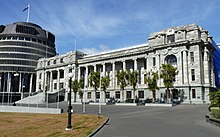New Zealand Parliament Pāremata Aotearoa | |
|---|---|
| 54th Parliament | |
 | |
| Type | |
| Type | |
| Houses | House of Representatives |
| Sovereign | King of New Zealand |
| History | |
| Founded | 24 May 1854 (first sitting)[1] |
| Leadership | |
Charles III since 8 September 2022 | |
Dame Cindy Kiro since 21 October 2021 | |
| Structure | |
| Seats | 123 |
 | |
House political groups | Government (68)
Official Opposition (34)
Crossbench (21) |
Length of term | Up to three years |
| Elections | |
House voting system | Mixed-member proportional representation |
Last House election | 14 October 2023 |
| Meeting place | |
 | |
| Parliament House, Wellington | |
| Website | |
| www | |
 |
|---|
|
|
The New Zealand Parliament (Māori: Pāremata Aotearoa) is the unicameral legislature of New Zealand, consisting of the Sovereign (King-in-Parliament) and the New Zealand House of Representatives. The King is usually represented by his governor-general.[2] Before 1951, there was an upper chamber, the New Zealand Legislative Council. The New Zealand Parliament was established in 1854 and is one of the oldest continuously functioning legislatures in the world.[3] It has met in Wellington, the capital of New Zealand, since 1865 and in its current building since 1922.
The House of Representatives normally consists of 120 members of Parliament (MPs), though sometimes more due to overhang seats. There are 72 MPs elected directly in electorates while the remainder of seats are assigned to list MPs based on each party's share of the total party vote. Māori were represented in Parliament from 1867, and in 1893 women gained the vote.[3] Although elections can be called early, every three years Parliament is dissolved and goes up for reelection.
Parliament is supreme over all other government institutions. The legislature is closely linked to the executive. The New Zealand Government comprises a prime minister (head of government) and other ministers; in accordance with the principle of responsible government, they are always selected from and accountable to the House of Representatives.
Neither the monarch (currently King Charles III) nor his governor-general participates in the legislative process, save for signifying the King's approval to a bill passed by the House, known as the granting of the Royal Assent, which is necessary for a bill to be enacted as law. The governor-general formally summons and dissolves Parliament—the latter in order to call a general election.
- ^ Cite error: The named reference
first sittingwas invoked but never defined (see the help page). - ^ McLean, Gavin (28 September 2016). "Governors and governors-general – Constitutional duties". Te Ara: The Encyclopedia of New Zealand. Retrieved 1 July 2017.
- ^ a b Martin, John E. (17 February 2015). "Parliament". Te Ara: The Encyclopedia of New Zealand. Retrieved 30 August 2016.